The unknown has always been fascinating, and monsters are among the most fascinating mysteries that capture people’s imagination. Bigfoot, Chupacabra, the Abominable Snowman, the Loch Ness Monster, aliens, vampires and the list can go on, as all sorts of legendary creatures stirred our curiosity even from childhood when they crept into the first fairy tales our parents read to us.
These mythical monsters hold an incredible fascination for so many people. We are always trying to find evidence to prove their existence and motivate our beliefs, and this is even more so when books and movies fuel our imagination.
The speculation about the Loch Ness Monster has started in 1933, when John Mackay and his wife spotted a creature in the middle of the loch as they drove past. A year later, on April 1, 1934, Dr. R. K. Wilson took a photo of the monster, which later became the proof that intrigued and fascinated many believers, who started to search it in the deep waters of the lake.
The possibility of a monster inhabiting a deep, dark Scottish loch has been a subject of debate since it first came to the world's attention, and the Loch Ness Monster is now a part of the Scottish culture.
Nessie, as the monster has been dubbed, has been described in many ways. Some say it has a long, slender neck and small horns, others believe it has flippers like a seal, and other reports describe it with humps like a camel.
In the past, it was widely believed that Loch Ness was a dark and desolate lake in the remote and deserted Scottish highlands because a mysterious creature was lurking in the loch. In 1933, when a road made the loch accessible to tourists, the truth of the legend was “confirmed” with 52 monster sightings in twelve months.
However, whether the Loch Ness Monster exists or not still has to be proven. And that’s what keeps the mystery alive and fascinates people. Over the years, there have been many stories and photos of sightings of the monster. Books about the Loch Ness Monster have also been published and fueled the mystery.
People have even conducted extensive searches in the deep waters of Loch Ness with underwater cameras and sonar equipment, but they have not found the monster.
Moreover, many of the alleged sightings proved to be either misidentifications of common animals, objects or effects, or pure hoaxes, and the cryptid was never documented by the scientific community. Even the famous “Surgeon’s photo” taken on April 1, 1933 by the respectable London doctor proved to be a hoax.
But not everyone believes that the photo is a fake and sightings of monsters still surface now and then. Although I am not convinced the Loch Ness monster is real, I do believe it’s possible there are large unknown creatures that have yet to be found and studied, as scientists often find evidence of animals never previously known to exist.
Recently, a routine check of the loch using Apple Maps satellite imagery revealed a mystery shadow which many said it could be Nessie. And yesterday, a sonar image from the depths of the Loch Ness which seemed to have also captured the mythical creature sparked new speculation about it.
Well, I guess it is fascinating to discover that a scan of the watery depths provides an unusual image of a mystery object on a screen. The unknown keeps the mystery alive. After seeing the image, probably most of us wonder what created it. What was there? Could it have been a seal, a big eel or a long-necked plesiosaur of the sort that have not been documented for 70 million years?

 14 DAY TRIAL //
14 DAY TRIAL //